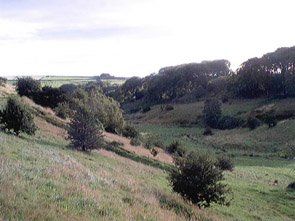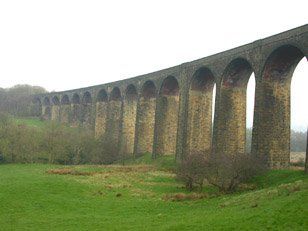- Home
- General Information
- Sightings
- Birding Locations
- Publications
-
Archive 1987 - 2018
- A Checklist of Bradford's Birds
- Swans & Geese
- Ducks & Sawbills
- Divers, Grebes, Herons
- Eagles, Kites & Harriers
- Buzzards & Hawks
- Falcons
- Grouse, Quail, Crakes
- Waders - Part1
- Waders - Part 2
- Skuas and Gulls
- Terns & Auks
- Doves, Nightjar & Alpine Swift
- Hoopoe, Wryneck, Larks, Pipits
- Owls, Woodpeckers
- Thrushes
- Warblers and Tits
- Shrikes and Crows
- Sparrows, Buntings and Finches
- Gallery
Oxenhope & Worth Valley
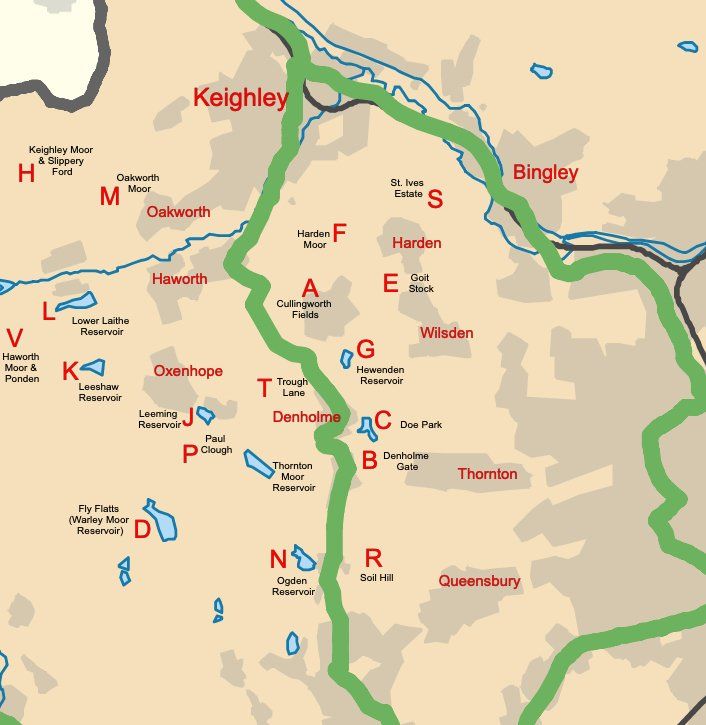
Creative Commons Attribution-Share Alike 3.0 Unported with additions by Bradford Ornithological Group (2018).
Oxenhope and Worth Valley
B Denholme Clough
C Doe Park, Denholme
D Fly Flatts (Warley Moor Reservoir)
E Goit Stock, Harden
F Harden Moor
G Hewenden, Cullingworth
H Keighley Moor and Slippery Ford
J Leeming Reservoir, Oxenhope
K Leeshaw Reservoir, Oxenhope
L Lower Laithe Reservoir, Stanbury
M Oakworth Moor
N Ogden Reservoir
P Paul Clough, Oxenhope
R Soil Hill, Queensbury
S
St. Ives Estate
T
Trough Lane, Denholme
V Haworth Moor and Ponden
A Cullingworth Fields These consist of the fields alongside Haworth and Keighley Roads. The fields alongside Haworth Road are also given the name Flappit Springs. These fields are of particular interest to Gull watchers as they can at times attract quite large numbers.. This was especially so when the Sugden End and Manywells Brow tips were in use. These fields are treated with waste from a local chicken processing company hence the interest from Gulls. Caspian, Yellow-legged, Glaucous and Iceland have been seen among the Herring, Great & Lesser Black-backed Gulls, while Mediterranean and Kittiwakes have been seen among Black-headed and Common Gulls. There are also very large flocks of Corvids present almost throughout the year which encouraged a Hooded Crow to spend the winter one year.
On top of that some of the fields adjacent to the Flappit Springs are occasionally planted with vegetables which make them superb places for winter finch flocks. In the winter of 2001/02 there were as many as 140 Brambling present. These Finch flocks attracted other species such as Reed Bunting, Linnet and Siskin to the area. In 1999 a Pipit showing characteristics of a Scandinavian Rock Pipit was seen feeding with Meadow Pipits.
In recent years the numbers of Gulls has been reduced due to the lack of any tips nearby but they still pass through the area. Winter flocks of Lapwing often have visiting Golden Plovers and Snipe use the boggier fields. One Spring a group of birders watched a Ring Ouzel on a wall while they checked the age of a Glaucous Gull.
B Denholme Clough
is south east of Denholme Village and runs north to Doe Park Reservoir. It is a small narrow valley which has steep sides and is surrounded by farmland. The valley itself is farmland but not as improved as the surround fields. Along the steep sides are scattered bushes, shrubs and trees. Denholme Beck flows north to Doe Park in the valley bottom. At the northern end is the old railway line sidings and a small bridge. The area north of this bridge up to Doe Park is a good area for migrant birds, especially in the autumn.
Though there are few breeding birds present the clough comes alive in during the autumn months. Flycatchers, Chats and Warblers can be found among the Finches and Thrushes. It is an excellent place to see Bullfinch in the Autumn as family parties move away from nearby breeding territories.
Visible migration has been watched at the northern edge over looking Doe Park and has produced some very good counts over the years. When the overhead birds stop moving the observers can concentrate their efforts on the trees and bushes to find migrants.
Species seen here include;
Honey Buzzard, Peregrine, Merlin, Knot, Grey Plover, Green Woodpecker, Kingfisher, Dipper, Grey Wagtail, Yellow Wagtail, Tree Pipit, Stonechat, Wheatear, Redstart, Reed Warbler, Sedge Warbler, Wood Warbler, Pied Flycatcher, Waxwing, Brambling, Crossbill, Redpoll, Siskin.
C Doe Park Reservoir
is a mid size body of water situated to the east of Denholme village. It is surrounded by farmland on three sides and has a small sewage works between it and Denholme. it is quite an open plane reservoir with only a few small trees and shrubs to obscure its shoreline. it is higher up the same valley as Hewenden Reservoir and it's river outlet eventually becomes Harden Beck. It is fed by Stubden Beck flowing East down from the Stubden and Thornton Moor Reservoirs and Denholme Beck flowing North down Denholme Clough.
Sadly from a birding point view it has a sailing club and a small group of fishermen that use it on a regular basis. These two factors definitely interfere with the birdlife as very few of the locally rare species linger.
To the immediate North East is an area of over grown damp shrubby grassland that has attracted birds such as Sedge Warbler, Whitethroat and Willow Tit. Along the eastern side is a very steep field with plenty of gorse bushes which are home to a lose breeding colony of Linnets and occasionally attract Stonechat.
The southern most edge is an excellent micro-habitat of marsh and shrubs which appears to be a good stop over place for spring and autumn migrants. Here birds such as Water Rail, Reed Warbler, Grasshopper Warbler & Pied Flycatcher have been seen among good numbers of common migrants. The Sewage works along the west side attract Wagtails and Pipits on the filter beds as well as Finches and Warblers in the bushes surrounding them.
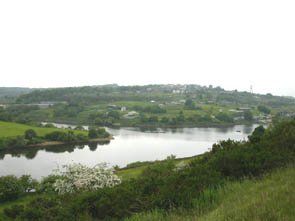
Doe Park is very quick to develop a shoreline all around but due to the disturbance seldom hangs onto the few waders that have been brave enough to stay. Needless to say waders such as Green Sandpiper, Greenshank, Redshank, Ringed Plover and Common Sandpiper have been seen to linger. Other waders, Bar-tailed Godwit and Knot have passed through. As well as waders migrant raptors have been seen with Hen Harrier, Honey Buzzard, Merlin and Peregrine all being recorded. A Kittiwake once spent almost an entire month visiting first thing in the morning with other Gulls during an autumn.
Resident wetland species are a bit thin on the ground but Kingfisher, Dipper and Grey Wagtail can be seen all year round.
D Fly Flatts (Warley Moor Reservoir) Fly Flatts, also known as Warley Moor reservoir is owned by Yorkshire Water and is a permit only area. However, the track down the north end of the reservoir is a public footpath which takes you over the moor. There is no access along the west banking.
The reservoir covers 90 acres and is home to the Halifax Sailing Club, the highest sailing club in England at 1350 feet above sea level. During the summer months, sailing lessons, races and several and wind surfing takes place. Conditions can be very challenging, strong winds in this exposed location often make sailing and birding difficult. There is no shelter around the water’s edge and although the winds almost always blow, fog and mist often settle on the quieter days. However, there can be rich rewards for those hardy enough to withstand the elements.
Brian Sumner, with over 50 years of visiting Fly Flatts, has produced a list of 116 species. These include 18 species of wader, 19 of waterfowl and 10 different raptors. In 2017, Great White Egret and Caspian Gull visited the reservoir. Rarities have included Great Northern Diver and Long-tailed Duck and regular passage visitors include Scaup, Whooper Swan and waders such as Turnstone, Sanderling, Knot and Bar-tailed Godwit. Dunlin, Redshank and Snipe breed on the surrounding moorland and Osprey pass through on their northerly journey and Buzzard and Red Kite are seen daily. Twite were once reasonably well-established, but they are in decline in this region. Other passerines to look out for include Stonechat, Whinchat and Wheatear which passes through in good numbers and possibly breeds in the area as newly fledged individuals are often seen in September.
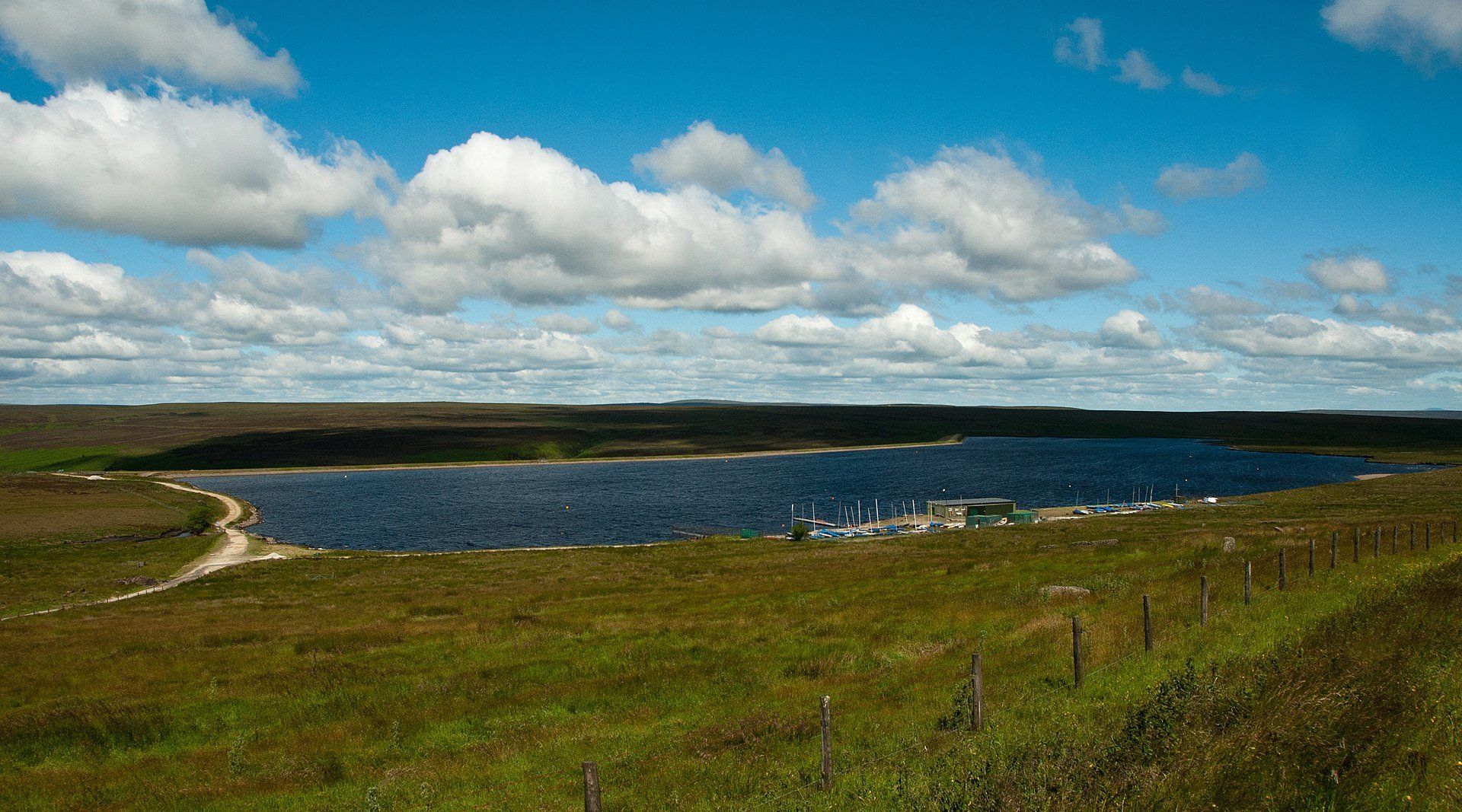

Whooper Swans on Warley Moor Reservoir
photo: Brian Sumner
E Goit Stock, Harden
is a wooded valley that follows the course of Harden Beck from the Hallas Bridge to the Malt Shovel Pub at Harden. It is predominantly a Silver Birch woodland with a few other more mature trees scattered throughout. The beck forms a couple of waterfalls, the larger of the two is pictured. There is an opening where a caravan park is situated and the woods are surrounded by grazing pasture. The bird life of Goit Stock is limited to common woodland species, though it can be good for Wood Warblers in May. Spotted Flycatchers can be found at Hallas Bridge from May onwards. There are at least two pairs of Dipper present along the river and Grey Wagtail usually breed. Kingfisher also inhabitant the river but are hard to see. Nuthatches have moved in during recent years, no doubt due to the maturing of the woods.
F Harden Moor
G Hewenden (Cullingworth) The Hewenden area is dominated by the reservoir but also includes an old railway viaduct and surrounding fields. Harden Beck runs from the reservoir to Hallas Bridge and the wooded beck-side runs into Goit Stock. The reservoir has a mature woodland around half of its area but doesn't yield a great deal of birdlife. The reservoir itself often doesn't hold many water birds no doubt due to the high numbers of fishermen on match days. It does, however, occasionally get a scarce bird. In the past Whooper Swan, Iceland Gull, and Yellow-legged Gull have been recorded here. Great Crested Grebes try to breed almost annually and have recently succeeded after many years of failure. Waders are generally not found at Hewenden but Redshank and Common Sandpiper are sometimes seen using the reservoir sides. Hewenden rarely shows any shoreline at all. Ducks other than Mallard are considered rarities.
The viaduct has a breeding colony of Swifts as well as Jackdaw and Stock Dove. The wooded beck-sides are quite good for Redpoll in the winter months. The scrubby area near the road side in the bottom of the dip between Harecroft and Cullingworth can be good for passage warblers. So far Lesser Whitethroat and Sedge Warbler have been recorded here as well as Willow Warbler, Blackcap and Garden Warbler. Little Owls use the dry stone walls in the surrounding farmland.
H Keighley Moor and Slippery Ford
J
Leeming Reservoir
is a pleasant location in the village of Oxenhope just off the Denholme road. It is best approached along the path from this road where there are ample parking spaces. The reservoir attracts interesting species from time to time. In 2004 a Slavonian Grebe was seen there, but usually it's waders that prove to be seen, particularly Common Sandpiper, Dunlin and Redshank.
Summary of 2017 records
photo: Nigel Priestley.
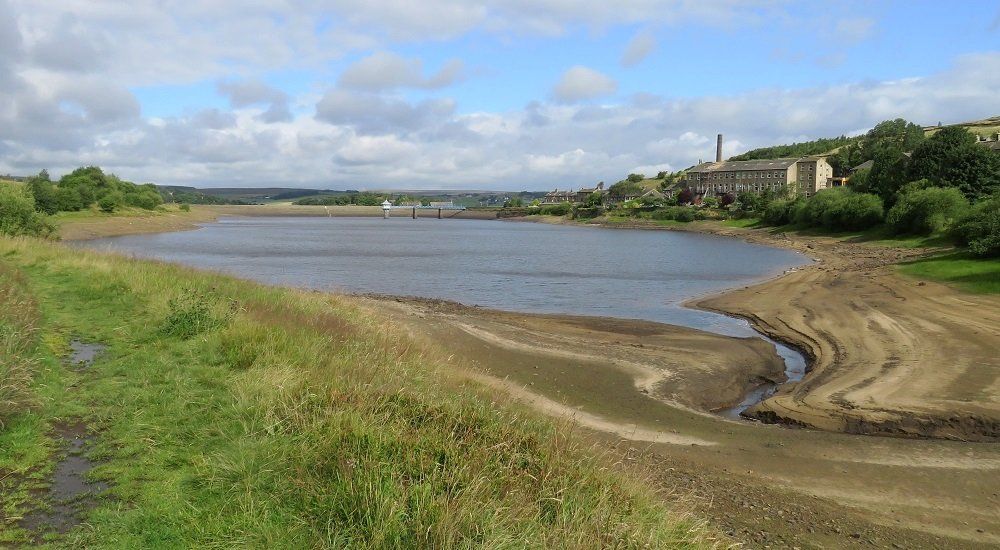

K Leeshaw
is a Pennine reservoir above 700 feet near Oxenhope, in the Bradford Ornithological Group Area. In common with most of these artifical lakes they are most interesting when the water level drops to reveal areas of mud. Common Sandpiper, Grey and Pied Wagtail breed around the waterside and Lapwing and passing waders feed on the exposed mud. In July 2005 a Little Egret was seen on the lake side. Ducks and Geese frequent the water during winter and some stay to breed, particularly Canada Geese.
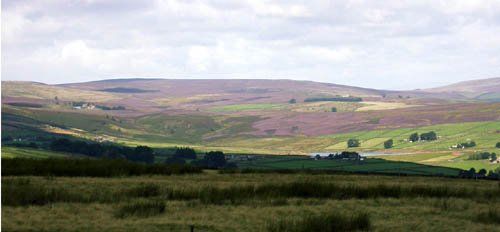
Lower Laithe Reservoir with Haworth Moor
L Lower Laithe Reservoir
is situated to the west of Haworth village and to the north-west of Penistone Country Park. Together with nearby, Ponden Reservoir it supplies water to communities within the Worth Valley and to the town of Keighley. This area has traditional connections with the Bronte Sisters and as a consequence, is heavily used by tourists who visit this extremely scenic location. Lower Laithe drains nearby Haworth and Stanbury Moors and these surrounding moorland areas provide excellent habitat for breeding birds such as Meadow Pipit, Linnet and Wheatear. The reservoir, is not particlularly noted for a large range of species, but it does attract roosting birds.and Goosander can be seen throughout the year.
M
Oakworth Moor
N
Ogden Water
was designated a Local Nature Reserve in 2003. The Estate comprises a 34 acre reservoir enclosed by woodland with open moor beyond. The heather uplands and peat moors form part of a Special Protection Area, that is of international importance for breeding birds. At Ogden Reservoir there is a small information centre giving details of the various species seen. Well-marked walks run around the reservoir and through the adjacent woodland. There are numerous woodland trails and waterside paths to explore, with stunning views extending across Calderdale.
Summary of records 2017
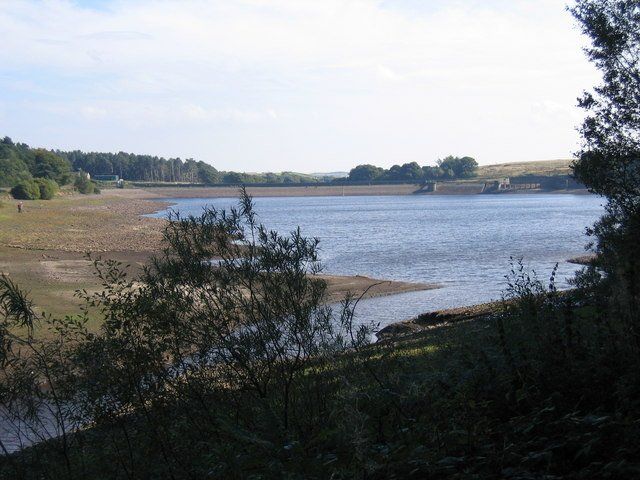
P Paul Clough, Oxenhope
R
Soil Hill (Queensbury)
is one of the highest points within the BOG area. Situated between the roads that lead south from Denholme, to Queensbury (A644) and Halifax (A629), it provides an excellent site to watch for some of the rarer visitors, Jack Snipe and Snow Bunting. In addition, Wheatear, Skylark, Linnet, Curlew, Stonechat and Whinchat are regularly to be seen at various times of the year.
S
The St.Ives Estate
is a woodland area with several other habitats scattered around the grounds. Along the southern part of the grounds is a mature oak woodland, Cuckoo's Nest, which backs on to grazing pasture. The Oak dominated woods give way to plantations of Conifer (eastern side) and Larch (western side), whereas the centre is where the old Mansion House, stables and out buildings are. To the north is the Heather Park, a heather moorland area which undoubtedly was part of Harden Moor in the past, and the Race Course Plantation which is a mature conifer wood. In the middle of the grounds is a golf course, former grazing pastures and current horse grazing pastures. Not far from the western entrance is Coppice Pond, a small man made lake, and next to this is Coppice Bog (an upland acid bog SSI designated).
As the habitat is diverse so is the bird life. With the oak woods come species such as Nuthatch, Jay, all three woodpeckers (Lesser-spotted being very scarce), Stock Pigeon, Spotted Flycatcher, and occasionally Pied Flycatcher. The conifer plantations have the usual suspects, Coal Tit, Goldcrest, Chaffinch with winter visits from Redpoll, Siskin and Crossbill. Racecourse plantation is the best spot for Redstart but numbers have declined since the 1990s. Heather Park has plenty of Meadow Pipits and in some years, Tree Pipits. Coppice Pond attracts little in the way of waterfowl other than Mallard, Canada Goose, Moorhen and Coot. Little Grebes sometimes winter and Kingfisher has been known to visit.
Rarities seen in the past have included Golden Oriole, Lesser-spotted Woodpecker, Firecrest, Black Redstart, Richard's Pipit, Honey Buzzard, and Hobby. Uncommon species to have occurred include Short-eared Owl, Whooper Swan, Common Buzzard, Merlin, Willow Tit, Pied Flycatcher, Wood Warbler (annually), and Yellowhammer.
T
Trough Lane
is an area of rough sheep pasture either side of the road from Manywells Height to the 'Dog and Gun' Public House above Oxenhope. This area has attracted birds on passage, particularly impressive are the numbers of Wheatears that rest and feed here during April and May and September and October. Stonechat probably have bred near the dry-stone walls and Black Redstart has been a surprise visitor. Most of the viewing is done from the bend in the road about mid-way between the two road-ends.
V Haworth Moor and Ponden

